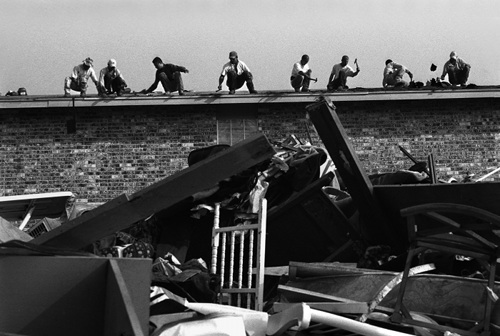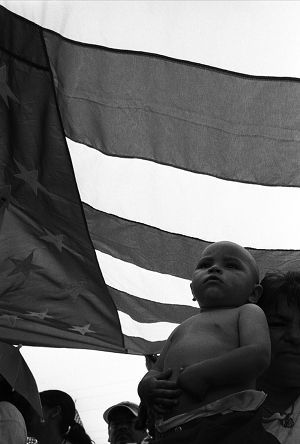The History Of The Future
Sep 3, 2009–Nov 13, 2010
Image Gallery


Immediatelly upon arriving on the Mississippi Gulf Coast from Beaumont, Texas, thirteen roofing workers are employed to fix an apartment complex at W. Pine and Hill, in Gulfport. There is one Honduran in the group; the rest are from San Luis Potosi, in Central Mexico.

Jimmy Frias, aged seventeen months old, U.S. citizen. His father is a soldier serving in Iraq. Phoenix, Arizona. April 10, 2006.

The History Of The Future
Sep 3, 2009–Nov 13, 2010
September 3 – November 13, 2009
Main Gallery
Featuring Michael Berman & Julian Cardona; curated by Nancy Sutor
Nancy Sutor, independent curator, the Lannan Foundation and Contemporary at Blue Star are pleased to present an exhibit titled The History of the Future, including photographers Michael Berman and Julian Cardona. The exhibit will open at Contemporary at Blue Star as part of FOTOSEPTIEMBRE on September 3, 2009 from 6 − 9 p.m. The exhibit continues through November 13, 2009 and it will travel to three other venues in the US over the next two years.
For over 30 years these artists have focused on the wild places in the desert southwest and the people crossing the lands where Mexico and the United States come together. The exhibition unfolds their multiple collaborations of the last seven years.
The topic of the border is one that each participant has deep and diverse knowledge. Michael Berman’s images of the land in the Arizona, New Mexico and Northern Mexico region contain the mysterious bleak beauty of that fragile place. Julian Cardona’s images are of people and place that he knows so well. Charles Bowden is an outspoken advocate for the desert Southwest since the 1970’s, a refreshing and essential voice.
Michael Berman was born in New York City in 1956, but came west to Colorado College where he studied biology. He received an MFA in photography from Arizona State University. Fifteen years ago he settled in southwestern New Mexico where he now lives in the Mimbres Valley near San Lorenzo.
His photographs are included in the collections of the Metropolitan Museum of Art, the Museum of Fine Arts , Houston, the Cleveland Museum of Art, the Amon Carter Museum and the Museum of New Mexico among others. Michael Berman is a 2008 recipient of a Guggenheim Fellowship.
He wanders the border wildlands of US and Mexico and works on the local issues – mining, grazing, wilderness, timber, water, growth and the border – that impact the land. To his art Berman brings an awareness of the complexity of the biological world; to the political and social dialogue of the West he brings his art as a catalyst to renew and heighten our perception of the land.
Michael Berman’s large format black and white digital prints embrace a modernist aesthetic. While many of the images contain much beauty and all are exquisitely visioned and printed, the classic heroicism inherent in modernism is replaced by a dedication to “what is there”. An image of a shredded bit of shirt and fragments of white plastic tangled in desert vegitation on a sandy patch of ground slowly form in one’s mind into the sling and remains of the water bottle it once was. The large prints allow the viewer to be surrounded by the image, be it a monumental rock face or a broken doll in the sand one is immersed in the formal elements of the piece yet the information, the truth of the place seeps in.
He says:
“Art gives form to the things we know, but cannot yet understand. Its symbolic structure allows us to approach complex ideas that would be lost under the weight of analytical language. Art can serve as a kind of incubator for nascent truths as they evolve a coherent meaning. Art can also elicit and galvanize the support of a larger community for complex ideas.” – M.P.B.
Julian Cardona was born in Zacateca, Mexico and lives in Juarez. He is a self-taught photographer who has published work in the newspapers El Fronterizo and El Dario de Juarez.
In 1995 he organized a group show called ”Nada que ver” (Nothing to See) which contained the work of photojournalists who document daily violence, death and poverty that accompanies life in Juarez. In 1998 Cardona’s work appeared in the book, Juarez: Laboratory of the Future, which features essays by Charles Bowden, Noam Chomsky and Eduardo Galeano. His work has appeared in Harper’s magazine and in Aperture No. 159, “Camera of Dirt” Cardona’s work has been exhibited in the Houston FotoFest 98: “Stories About Us;” in “Borders and Beyond,” an international group show organized by Pro Helvetia, Arts Council of Switzerland; in “Lines of Sight: Views of the U.S./Mexican Border, at galleries of the University of California at Riverside, Santa Cruz and Merced; and in Photography Past/Forward: Aperture at 50, at Sotheby´s New York in January 2003 and in the Golden-Anniversary publication of the same title. In 2004, Cardona received the Cultural Freedom Fellowship awarded by the Lannan Foundation of Santa Fe. His work about immigration was on exhibition at the CUE Art Gallery, in New York City on October 2005.
Julian Cardona’s black and white photographs tell many stories. True to a documentary tradition they record social and political situations with the aim of conveying information, but they do so much more. Images of rallies and marches, of migrants and minutemen, a woman sleeping with a newborn baby the father keeping watch, all convey the honor and humanity of the subjects. A resident of Juarez where daily life includes gunshots, rape murders and disappearances Julian Cardona is clearly familiar with the desperation that his subjects live. He also knows the dreams they hold and the incredible power of the photographic image.
In his essay WORLD CLASS CITY Julian Cardona writes:
“In the beginning, Juárez barely glimmered in the pale light. Factories bloomed like cement flowers in the desert. Unemployment dwindled to the lowest rate in the hemisphere. Foreign investment boomed as world-class products were manufactured on every street corner.
Many who came to cash in on the bonanza saw their cardboard and pallet houses burn, their daughters disappear. Narco became a new word to them. Narco filled their dreams and schooled their children. And when blood ran in the streets, their cries vanished into the dark and the silence.
At the dawn of the new millennium, things change. The eyes of the world turn toward Juárez. A veil lifts. Now we see faces crying for help from the darkness. It seems to signal hope—an end to the atrocities of the time and place.
Years pass. Nothing changes…..
Juárez unmasks our failed ideas of state, society, war and justice. Most Juárez residents gain nothing from the unsustainable World Class manufacturing that dominates the city’s legitimate economy. And people with nothing left to lose make an easy switch to the infinitely profitable—and deadly—economy of World Class crime.
We flock to the border to see the faces of Juárez, to hear their cries for help. But we do not hear and the faces cannot answer. Nothing changes.
Day by day, we invent mythology to explain Juarez. This always fails.
Juárez blows like cold wind through the windows of our souls and demands our attention. We embrace its images as if they could fill our own empty spaces, but we cannot hold on. We do not discover Juárez: Juárez discovers us.
Before, we were blinded by darkness, now, by too much light.”